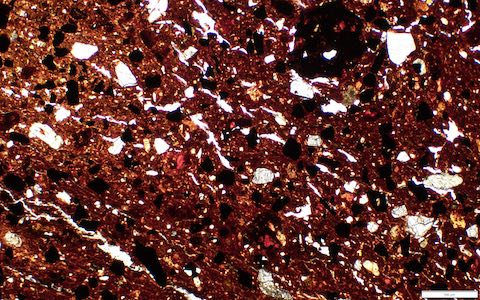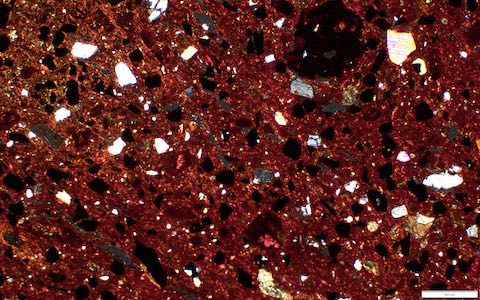Mineral and Rock Abundances
| None (0) | Minor (1) | Few (2) | Common (3) | Frequent (4) | Major (5) | Very Dominant (6) |
| 0% | 0-5% | 5-15% | 15-30 % | 30-50% | 50-70% | 70-100% |
| Name | Cal. | Quartz | Feldspar | Pyroxene | Amphibole | Opaques | Olivine | Biotite | Muscovite | Epidote | Garnet/ Spinel | Ig./Met. Rocks | Sed. Rocks | Grog | Lithics/ Region |
|---|---|---|---|---|---|---|---|---|---|---|---|---|---|---|---|
| Max | 0 | 1 | 2 | 3 | 0 | 5 | 0 | 0 | 0 | 0 | 0 | 1 | 0 | 0 | na |
| Min | 0 | 1 | 2 | 3 | 0 | 5 | 0 | 0 | 0 | 0 | 0 | 1 | 0 | 0 | PNG |
Representative slides:
| Slide | Site | Possible Origin | Cal. | Quartz | Feldspar | Pyroxene | Amphibole | Opaques | Olivine | Biotite | Muscovite | Epidote | Garnet/ Spinel | Ig./Met. Rocks | Sed. Rocks | Grog | Lithics |
|---|---|---|---|---|---|---|---|---|---|---|---|---|---|---|---|---|---|
| IL_1_37 | Sio (Png) | Madang | 0 | 1 | 2 | 3 | 0 | 5 | 0 | 0 | 0 | 0 | 0 | 1 | 0 | 0 | na |
IL_1_37


Madang style. CAUTION: Section less than 30microns. This sherd is characterized by angular to subrounded magnetite grains (5%) less than 0.2 mm in length. Pyroxene grains (1%) are less than 0.2 mm in length. Plagioclase grains (<1%) are generally less than 0.2 mm in length. But there are rare grains of quartz and feldspar up to 1 mm across. There are also trace amounts of red ferruginized grains and rare shell in the red clay.